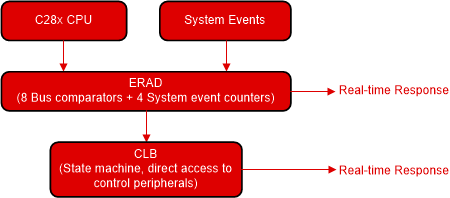-
Embedded Real-Time Analysis and Response for Control Applications SPRACM7 December 2020 F29H850TU , F29H859TU-Q1 , TMS320F280021 , TMS320F280021-Q1 , TMS320F280023 , TMS320F280023-Q1 , TMS320F280023C , TMS320F280025 , TMS320F280025-Q1 , TMS320F280025C , TMS320F280025C-Q1 , TMS320F280040-Q1 , TMS320F280040C-Q1 , TMS320F280041 , TMS320F280041-Q1 , TMS320F280041C , TMS320F280041C-Q1 , TMS320F280045 , TMS320F280048-Q1 , TMS320F280048C-Q1 , TMS320F280049 , TMS320F280049-Q1 , TMS320F280049C , TMS320F280049C-Q1 , TMS320F28384D , TMS320F28384D-Q1 , TMS320F28384S , TMS320F28384S-Q1 , TMS320F28386D , TMS320F28386D-Q1 , TMS320F28386S , TMS320F28386S-Q1 , TMS320F28388D , TMS320F28388S , TMS320F28P550SJ , TMS320F28P559SJ-Q1 , TMS320F28P650DH , TMS320F28P650DK , TMS320F28P650SH , TMS320F28P650SK , TMS320F28P659DH-Q1 , TMS320F28P659DK-Q1 , TMS320F28P659SH-Q1
Embedded Real-Time Analysis and Response for Control Applications
Trademarks
C2000 is a trademark of Texas Instruments Incorporated.
All trademarks are the property of their respective owners.
1 Introduction
The critical need for any real-time closed loop control system is to remain stable throughout life, as shown in Figure 1-1, and have a way to handle any out-of-bound system scenario in the safest possible way. At the time of design, the control systems are architected to handle a range of system variables, parameters and scenarios.
When the system is in use, if any of these variables or parameters were to go beyond what the control loop is designed for, then the stability of the whole system is at stake. While real-time debug and trace techniques exist, these can only help in a development environment with a debugger or trace receiver hooked up. These technologies cannot be used once the system is actually functioning in the end equipment.
A good example of such a scenario is a motor controller in servo drive or any real time motor in an electric vehicle. In a development environment, real-time debuggers and trace technologies can be used to collect data, perform offline analysis and use this to tune and modify the system. But once this goes into a production system, the above said mechanism for on-chip monitoring is a critical requirement.
C2000 MCU architecture includes a new and advanced peripheral Embedded Real-time Analysis & Diagnostic (ERAD) that facilitates sophisticated non-intrusive detection and monitoring of the MCU operation in real time. This mechanism in the architecture can run in parallel to the main CPU along with the user application. In the event of detecting a dangerous situation in the architecture, the hardware mechanism helps with a quick response to address the problem by taking the best possible corrective action runtime.
 Figure 1-1 Basic Elements of a Control
System
Figure 1-1 Basic Elements of a Control
SystemWith a typical control loop, the transfer function can be described as a sequence of operations starting with the input peripherals (like the analog-to-digital converter (ADC) that creates inputs for the control routine), the critical system software running on the CPU doing the necessary computations and deciding the next set of actions on the output peripherals (like the PWM). The exact sequence and details of such system an operation will be different for different end applications. However, in all real-time systems, sequences like the one described above need to run within a certain time period. If not, there will be serious implications since they are controlling equipment’s like motors and power supplies.
A lot of care is taken during the development phase to handle out of range inputs and different system use conditions. However, when these systems go into a production environment, there is certainly a possibility of encountering something beyond what the system designer had anticipated during development. While there is no expectation for the system to function properly under such out-of-bound conditions, it is quite important that this situation be handled in a graceful manner without any significant damage to the final end equipment. It is this detection and handling that poses a significant challenge in real-time systems and it is here the ERAD peripheral will come to rescue the system designer.
ERAD can be used to realize hardware breakpoints and few more profiling options are available with debugger connected, but focus is purely on run-time monitoring and diagnostics in the coming sections.
1.1 What is ERAD?
ERAD is a hardware module that can be configured to non-intrusively monitor and profile critical CPU buses and device events.
ERAD is a hardware module with enhanced bus comparators and system event counters and sits within the MCU bus architecture as shown in the overview diagram. ERAD on its own can generate system level interrupts and flags and can also feed into other peripherals such as the CLB (configurable logic block) for further enhancing the capabilities. For complete understanding of the relationship between these two modules, see the CLB documentation located in the device-specific TRM.
 Figure 1-2 ERAD Block Diagram
Figure 1-2 ERAD Block Diagram